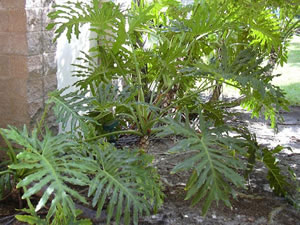The trees and shrubs that provide the rainforest with a framework also provide support for climbers and stranglers.
Climbers, such as lianas, depend upon other plants for support, but have their own root system in the ground.
Stranglers are climbing plants that start life as epiphytes - plants that grow entirely on other plants, and have no contact with the ground - but later become rooted in the ground.
Climbers
Many small herbaceous climbers can often be found at forest edges, in gaps made by falling trees, and in abandoned clearings. They form dense masses of green-ery over other vegetation.
 The members of the cucumber family (Cucurbitaceae) are particularly common in such sites. They have small yellow male and female flowers that may be borne on separate plants.
The members of the cucumber family (Cucurbitaceae) are particularly common in such sites. They have small yellow male and female flowers that may be borne on separate plants.
The fruits usually ripen to red or yellow and are quickly eaten by birds and animals, which then disperse the hard seeds in their dung. Such small, sun-loving climbers enjoy a short spell of rapid growthbefore the gaps that allow direct sunlight to reach them are closed by the young trees.
To escape the gloom of the forest floor, stem climbers attach themselves to the trunks of taller trees by short, suckerlike roots. These roots probably absorb water and nutrients from the tree bark surface, as do those of epiphytes.
The stem climbers are also known as hemiepiphytes.
A number of them belong to the arum family (Araceae). They are characterized by large, dark-green leaves that have a leathery texture.
They may climb high enough to reach the crown of their supporting trees, where they produce larger leaves and flowers, as well as long ropelike roots that hang down and may root into the ground below.
 Many of the large climbers of the tropical rainforest, such as the Swiss cheese plant, Monstera deliciosa, and species of Scindapsus and Philodendron and make attractive houseplants.
Many of the large climbers of the tropical rainforest, such as the Swiss cheese plant, Monstera deliciosa, and species of Scindapsus and Philodendron and make attractive houseplants.
All have spikes of tiny flowers, partly concealed by a hoodlike leafy spathe. In the Swiss cheese plant, these develop into an edible fruit.
Stranglers
The most common stranglers are the figs.
These plants are found on all the continents. They start life as epiphytes, germinating in hollows in tree crowns where a little soil has accumulated.
At first, they grow slowly, for there is little water or food for them, but their leathery leaves reduce water loss.
Later, they put out long roots that ultimately descend the trunk of the supporting tree and root into the soil beneath it. Once this occurs, the expanding leafy crown of the strangler starts to shade the crown of the support, while its roots interlace around the supporting trunk and appear to strangle the host.
Eventually, the supporting tree dies, probably as a result of competition for light, water and nutrients.